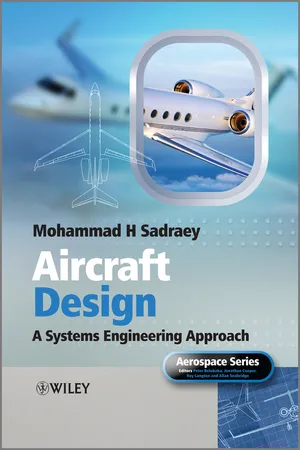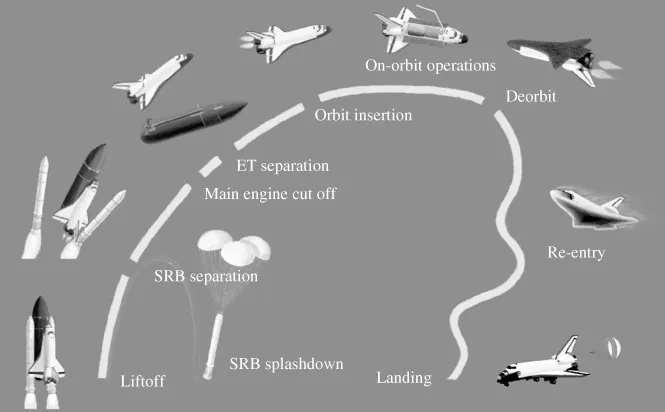![]()
Chapter 1
Aircraft Design Fundamentals
1.1 Introduction to Design
Aircraft design is essentially a branch of engineering design. Design is primarily an analytical process which is usually accompanied by drawing/drafting. Design contains its own body of knowledge, independent of the science-based analysis tools usually coupled with it. Design is a more advanced version of a problem-solving technique that many people use routinely. Design is exciting, challenging, satisfying, and rewarding. The general procedure for solving a mathematical problem is straightforward. Design is much more subjective, there is rarely a single “correct” answer. The world of design involves many challenges, uncertainties, ambiguities, and inconsistencies. This chapter is intended to familiarize the reader with the basic fundamentals and overall process of design. This book has been written primarily to provide the basic tools and concepts required to create an optimum/efficient aircraft design that will meet the necessary design requirements.
A very basic and simplified model of a design process is shown schematically in Figure 1.1. In general, a design process includes three major operations: analysis, synthesis, and evaluation. Analysis is the process of predicting the performance or behavior of a design candidate. Evaluation is the process of performance calculation and comparing the predicted performance of each feasible design candidate to determine the deficiencies. The noun synthesis refers to a combination of two or more entities that together form something new. In this text, synthesis is employed interchangeably with design. Hence, synthesis is defined as the creative process of putting known things together into new and more useful combinations. Synthesis is the vehicle of the design, with evaluation being its compass. The candidate designs that fail to satisfy (partially or completely) the requirements are reiterated. That is new values, features, characteristics, or parameters are determined during synthesis operation. The redesigned candidate is reanalyzed again for compliance with the design requirements. This iterative process is continued until the design requirements are met. A design process requires both integration and iteration, invoking a process that coordinates synthesis, analysis, and evaluation. These three operations must be integrated and applied iteratively and continuously throughout the lifecycle of the design.
A design operation often involves two activities: (i) problem solving through mathematical calculations and (ii) choosing a preferred one among alternatives (Figure 1.2). The first activity is performed in Chapters 4–12 in designing various aircraft components. The second design activity is in general a decision-making process. The fundamentals of decision making are reviewed in Section 1.4; and employed entirely in aircraft conceptual design (Chapter 3). In addition, there are various decision-making processes in aircraft components design (e.g., wing design, tail design, and propulsion system design), as will be discussed in several chapters. The major components that comprise a conventional aircraft are wing, fuselage, horizontal tail, vertical tail, engine, landing gear, and equipment. The decision-making process plays a significant role in the configuration design of these primary components.
The traditional engineering education is structured to emphasize mathematics, physical sciences, and engineering sciences. The problem is the lack of sufficient concentration on design and creativity. Creative thinking and its attitudes are essential to design success. Producing a new design requires an ability to be creative and overcome strong barriers. To address this significant issue a new organization, CDIO,1 was established in the late 1990s. The CDIO initiative is defined to be an innovative educational framework for producing the next generation of engineers. The framework provides students with an education stressing engineering fundamentals set within the context of conceiving/designing/implementing/operating real-world systems and products. This textbook has been written with a strong emphasis on creativity, and the freedom of the designer to go beyond current aircraft designs.
Throughout this text, various techniques for generating creative design alternatives are introduced. An effective approach in creative design as a source of new ideas is brainstorming. Brainstorming is a structured group-oriented technique for conceiving design alternatives. It consists of a group of individuals letting their imaginations run wild, but in accordance with central procedural rules. The ultimate goal is that the group members will inspire and support each other. The outcome is that the group will be able to conceptualize design alternatives that are more elegant than those the individuals could have achieved independently. In order to encourage members to describe their ideas, even totally impractical ones, a crucial brainstorming rule is that no criticism of individuals or ideas is permitted. The emphasis is on generating as many ideas and concepts as possible, without worrying about their validity. Rectifying, organizing, and combining the ideas suggested in a brainstorming session is performed out of the group meeting. The brainstorming technique is mainly applicable at the conceptual design phase (see Chapters 2 and 3).
In general, aircraft design requires the participation of six (Figure 1.3) fundamental disciplines: (i) flight dynamics, (ii) aerodynamics, (iii) propulsion, (iv) aero-structure, (v) management skills, and (vi) engineering design. The first four items are primary expertise areas of aeronautical engineering. This text has no particular chapters on any of these four topics; so the reader is expected to be familiar with the fundamentals, concepts, technical terms, and engineering techniques in such areas. Management is defined [1] as coordinating work activities so that they are completed efficiently and effectively with and through other people. An aircraft designer needs to be equipped with managerial skills and act as a manager throughout the design process. This topic is not covered in this text; however, a few aspects of management—such as project planning and decision making—are reviewed in this chapter (Sections 1.3 and 1.4).
Finally, engineering design [2–4] is at the heart of the design process and is assumed as the sixth discipline necessary for design of an air vehicle. Section 1.2 briefly examines various aspects of engineering design. It must be noted that aircraft engineering design has its own science, concepts, fundamentals, technical terms, and techniques. Chapters 3–12 all address various aspects of designing aircraft components as well as introducing aircraft design procedures.
This chapter will first examine the engineering design profession. Next, design project planning is addressed and tools such as Gantt charts are introduced. Then the principle of decision making, a very significant section of any design process, is presented. Feasibility study is also discussed in Section 1.5. Finally, the tort of negligence will be described to warn aircraft design engineers to take the utmost care in order to prevent liability.
1.2 Engineering Design
Aircraft design is essentially a branch of engineering design. Design is the culmination of all engineering activities, embodying engineering operations and analysis as tools to achieve design objectives. Many engineering professors find it more difficult to teach design than to teach traditional engineering science-based analytical topics. Every undergraduate engineering curriculum has a design component, although the extent and structure of that component may vary widely. Engineering design fundamentals are common to all engineering disciplines – aeronautical, mechanical, electrical, civil, and computer. Engineering design is a methodical approach to dealing with a particular class of large and complex projects. Engineering design provides the design engineer with a realistic design process. Design is the central activity of the engineering profession, and it is concerned with approaches and management as well as design techniques and tools. In this section, the fundamentals of engineering design as well as the definitions of a few technical terms are presented.
There is a clear distinction between classical mathematics and science problem-solving techniques, and design operation. There is inherently a beauty embedded in the design process which is usually felt after the design output is created. The mathematics and science problems have three main features: (i) the problems are well-posed in a compact form, (ii) the solutions to each problem are unique and compact, and (iii) the problems have an identifiable closure. However, a real-world engineering design problem does not share these characteristics. In fact, engineering design problems are usually poorly posed, do not have a unique solution, and are also open-ended. The Accreditation Board of Engineering and Technology (ABET) [5] defines engineering design as follows:
Just as the ABET statement is only one of many definitions of engineering design, there are several approaches to describing how design is done. This text formalizes the ABET description into a simplified step-by-step model of the design process based on a systems engineering approach [6]. A very basic block diagram of the design process is shown in Figure 1.4. It represents the road from customer need to design output, including feedback based on evaluation. The problem formulation is discussed in this section, and project planning is examined in Section 1.4. A large part of this text is on design operations, including Chapters 3–12.
The evaluation not only influences the design operation, but most of the time may affect problem formulation and project planning. A clear current example is the Space Shuttle, which started in 1981 but retired in 2011. After more than 30 years of successful operations (135 space missions), the National Aeronautics and Space Administration (NASA) figured out that the current design concept is not viable. Besides economic factors, two reasons that forced NASA to re-engineer the Space Shuttle (Figure 1.5) are the disasters that happened in 1986 and 2003. On January 28, 1986 Space Shuttle Challenger broke apart, just 73 seconds into its flight, leading to the deaths of its seven crew members. On February 1, 2003, shortly before it was scheduled to conclude its 28th mission, Space Shuttle Columbia disintegrated over Texas during re-entry into the Earth's atmosphere, resulting in the death of all seven crew members. Until another US launch vehicle is ready, crews will travel to and from the International Space Station aboard Russian Soyuz spacecraft or possibly a future American commercial spacecraft.
After the need is clearly defined, the designer has to turn his/her attention to describing how he/she envisions meeting the need. This fundament...





